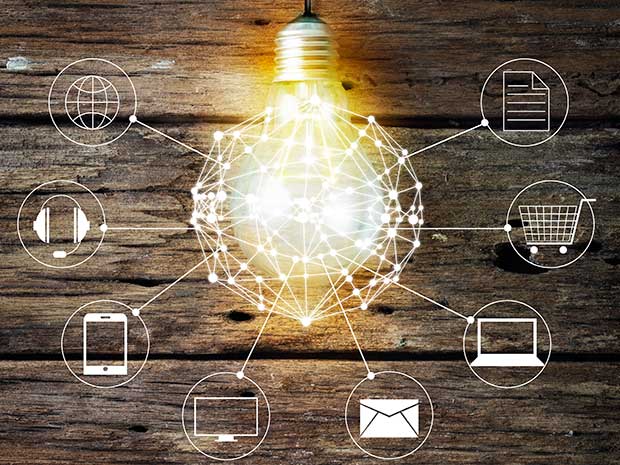
Hey Readers! One of the scary things about this article is that it was written two years ago. The ability of LED to carry and transmit information…gee, any possible link to the industry/government push years ago to buy LED lightbulbs in the name of efficiency and make the old bulbs obsolete? The old bulbs are barely found anymore, and when they are, they strangely seem to last about 5 days! It is hard to find information outlining this plan and what has, is and will go on with LED’s in our world. I have seen it online but can’t find it anymore so if any of you have a link to any information that can be posted on our website, please put it in the comment section. Combined with the 5G rollout, is the plan almost complete? thanks for the help, DK
Enabled by networked, sensor-laden LED bulbs, today’s lighting systems no longer just illuminate a dark room or a street, but watch over you and make decisions on your behalf. They could help you decide what to make for dinner and help you navigate a grocery store to find recipe ingredients. They also could alert you if someone is lurking in your yard.
Shopping malls, office buildings, schools, hospitals, and cities are replacing incandescent and sodium-vapor bulbs with LEDs, which not only provide automation and energy savings, but also the ability to monitor what people do and collect information about them. The systems include environmental and occupancy sensors as well as chips that enable Wi-Fi connectivity integrated into the bulbs, and software to collect and analyze data from the sensors.
Millions of LED bulbs are expected to be installed around the world in the coming years, wirelessly connected to the Internet. In fact, experts say, LEDs will make up a significant portion of the Internet of Things, in which devices will be able to communicate with one another.
“These systems see everything,” says IEEE Fellow Zary Segall, CEO of Selitera, which develops smart lighting systems for shopping malls and retailers. For those concerned about what these systems will mean for privacy, he says, “How much do you think we have now?”
MAKING THE SWITCH
LED bulbs are integrated with microcontrollers to enable applications beyond illumination. LEDs for the home, for example, might include built-in chips to enable connectivity to a personal Wi-Fi network, syncing with a smartphone app or virtual assistant to control the lights.
The bulbs can be purchased from electronic and home improvement stores, or online, for about US $35 each. Such bulbs allow users to control their lights remotely, and track their energy usage. They are available in 60- to 100-watt equivalents, and each bulb offers brightness levels from “soft white” of 2,700 Kelvin to “daylight” of 6,500K.
Commercial intelligent lighting systems can be retrofitted into or replace existing systems because the LED bulbs fit into the same sockets.
The retail industry is one of the biggest users of intelligent lighting systems. Simon Property Group, which owns more than 200 malls worldwide, has installed an LED system in its properties. The system can sync with the mall’s mobile app. Customers who download the app receive coupons on their smartphone as they enter Simon’s stores. The mall’s outdoor LEDs use occupancy sensors to detect empty parking spots and notify shoppers through the app of available spots in their car’s vicinity.
Philips’ LED indoor-position-sensing technology is being used by the Carrefour grocery store in Lille, France. Consumers who download the store’s app are notified which items they walk past are on sale. The app provides an interactive map to help shoppers find what they need.
The systems rely on visual-light communication (VLC) technology, which can send signals at up to 500 megabits per second through LEDs, allowing shoppers to receive alerts as soon as they walk by a product. Moreover, the technology determines a person’s indoor location, similar to GPS technology for outdoors, as well as the direction a shopper is facing, to detect which items she is browsing. If a shopper is lingering at a cosmetics counter, for example, the app can send her coupons for a makeup brand, explains Mary Lindenmuth of the Pompeo Group, an executive recruitment firm for the lighting industry, in Carlsbad, Calif.
Several of Lindenmuth’s clients are implementing smart lighting systems to determine how space is being utilized in their office buildings. “Instead of expanding its square footage as the number of staffers increases,” she says, “the company analyzes the information about usage from the lighting systems to see, for example, that a conference room is used only 10 percent of the time and therefore could be turned into an office space.”
LIGHTING THE WAY
Kim Molloy, a civil engineer with Parsons Brinckerhoff, in Montreal, works on installing intelligent lighting systems for smart cities. Using a control system, streetlights can be adjusted remotely by the city’s transportation department based on, say, weather or pedestrian traffic. Instead of employing utility workers to drive around looking for burnt-out bulbs, the system notifies city workers when a bulb needs to be replaced. And with LED bulbs typically lasting 100,000-plus hours, Molloy notes, they do not need to be replaced nearly as often as sodium-vapor bulbs, which are commonly used for streetlights.
Molloy says many of her clients plan to add additional functions to the LEDs, including the ability to connect them wirelessly to a security system. Programmed to identify the sound of a gunshot, for example, the lights would then turn on automatically at full brightness, making it easier to see a perpetrator on surveillance cameras, and would alert the police.
Disclaimer: We at Prepare for Change (PFC) bring you information that is not offered by the mainstream news, and therefore may seem controversial. The opinions, views, statements, and/or information we present are not necessarily promoted, endorsed, espoused, or agreed to by Prepare for Change, its leadership Council, members, those who work with PFC, or those who read its content. However, they are hopefully provocative. Please use discernment! Use logical thinking, your own intuition and your own connection with Source, Spirit and Natural Laws to help you determine what is true and what is not. By sharing information and seeding dialogue, it is our goal to raise consciousness and awareness of higher truths to free us from enslavement of the matrix in this material realm.
 EN
EN FR
FR


























This is creepy, and might explain the headaches I have been having. I never feel well after grocery shopping.
As someone who already gets debilitating headaches and concussion like symptoms when subjected to 120hz flicker from LEDs this idea scares the crap out of me. I will go back to candlelight before I buy an Led fixture and the street lights right now are already not tolerable with their flickering.
The technology is called Li-fi there’s a TED Talk on it, the l.e.d bulbs flicker so fast your eyes don’t detect any flicker, the light pulses are on 1 and off zero so the flicker is binary code and thus data can be sent and received this way.
Thanks for the info!